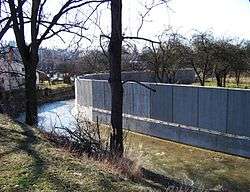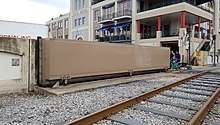Flood wall
A flood wall (or floodwall) is a primarily vertical artificial barrier designed to temporarily contain the waters of a river or other waterway which may rise to unusual levels during seasonal or extreme weather events. Flood walls are mainly used on locations where space is scarce, such as cities or where building levees or dikes (dykes) would interfere with other interests, such as existing buildings, historical architecture or commercial use of embankments.


Flood walls are nowadays mainly constructed from pre-fabricated concrete elements. Flood walls often have floodgates which are large openings to provide passage except during periods of flooding, when they are closed. As a flood walls mostly consist of relatively short elements compared to dikes, the connections between the elements are critical to prevent the failure of the flood wall.
The substantial costs of flood walls can be justified by the value of commercial property thus protected from damage caused by flooding.
Flood walls are almost always built in cities, notably:
- Cincinnati, Ohio
- Cologne, Germany
- Columbus, Ohio
- Coralville, Iowa
- Deventer, the Netherlands
- East Grand Forks, Minnesota
- Grand Forks, North Dakota
- Huntington, West Virginia
- Kampen, the Netherlands
- Kansas City, Missouri
- Louisville, Kentucky
- Memphis, Tennessee
- Morgan City, Louisiana
- New Orleans, Louisiana
- Nijmegen, the Netherlands
- Ottawa, Kansas
- Paducah, Kentucky
- Parkersburg, West Virginia
- Portsmouth, Ohio
- Richmond, Virginia
- Scranton, Pennsylvania
- South Williamson, Kentucky
- St. Louis, Missouri
- Williamson, West Virginia
- Woodland, Washington
In September 2005, following Hurricane Katrina, New Orleans, Louisiana, was substantially flooded after its system of levees and flood walls failed due to soil conditions and poor design.
See also
External links
| Wikimedia Commons has media related to Floodwalls. |
- DeltaWorks.Org Flood Barriers project in the Netherlands
